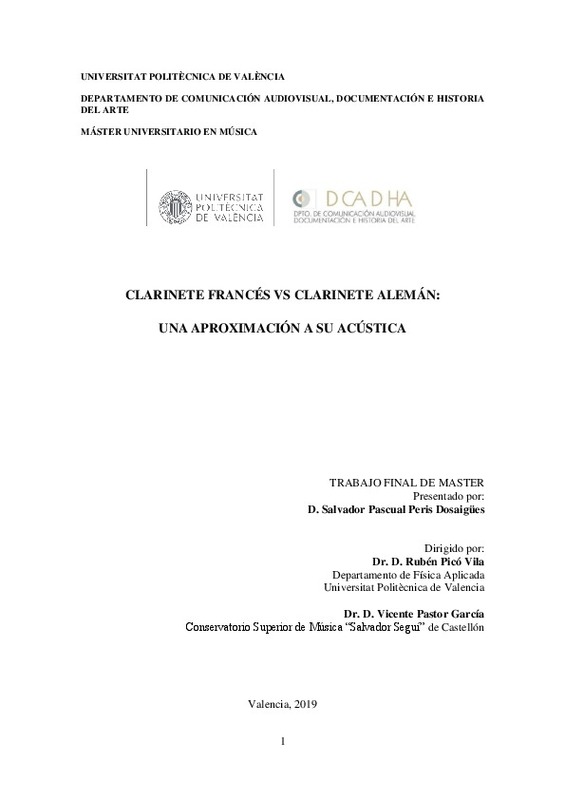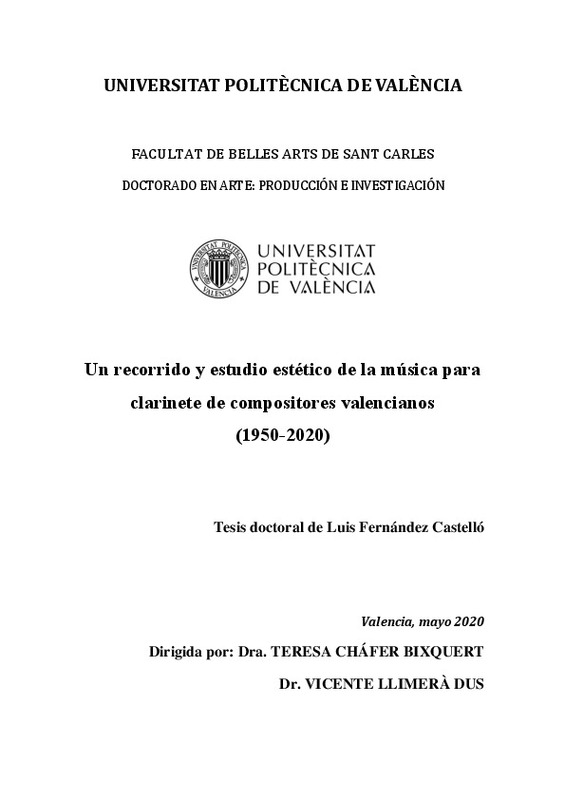JavaScript is disabled for your browser. Some features of this site may not work without it.
Buscar en RiuNet
Listar
Mi cuenta
Estadísticas
Ayuda RiuNet
Admin. UPV
Clarinete francés vs clarinete alemán: una aproximación a su acústica
Mostrar el registro sencillo del ítem
Ficheros en el ítem
| dc.contributor.advisor | Picó Vila, Rubén
|
es_ES |
| dc.contributor.advisor | Pastor García, Vicente Mateo
|
es_ES |
| dc.contributor.author | Peris Dosaigües, Salvador Pascual
|
es_ES |
| dc.coverage.spatial | east=2.213749000000007; north=46.227638; name= França | es_ES |
| dc.coverage.spatial | east=10.451526000000058; north=51.165691; name= Alemanya | es_ES |
| dc.coverage.spatial | east=14.550072; north=47.516231; name=Àustria | es_ES |
| dc.date.accessioned | 2019-10-21T13:53:23Z | |
| dc.date.available | 2019-10-21T13:53:23Z | |
| dc.date.created | 2019-07-18 | |
| dc.date.issued | 2019-10-21 | es_ES |
| dc.identifier.uri | http://hdl.handle.net/10251/129140 | |
| dc.description.abstract | [ES] La historia del clarinete se ha visto influenciada principalmente por dos escuelas, las que a su vez estaban ligadas al diferente tipo de construcción del instrumento. Esta diferente forma constructiva del clarinete tuvo lugar en distintos momentos históricos y geográficos, pero sobretodo por las diferencias físicas en cuanto a las dimensiones internas del instrumento, colocación de las llaves y hoy en día en diferentes tipos del conjunto boquilla-lengüeta. Todo este tipo de particularidades, hizo que se diferenciaran dos tipos de instrumentos, el clarinete alemán y el clarinete francés. Las dos principales diferencias entre los dos instrumentos que encontramos se podrían enumerar en: ¿ Objetiva, la construcción del instrumento, colocación de las llaves, dimensiones del tubo. ¿ Subjetiva, la sonoridad emitida por el instrumento y la percepción sonora que tiene el oyente. Este trabajo pretende incidir en la posible relación que pueda existir entre la construcción del instrumento y el diferente tipo de sonoridad emitida por el instrumento y percibida por el oyente por cada uno de los dos sistemas constructivos, alemán y francés. El estudio constará de tres partes: 1) Marco teórico, con todos los conceptos relacionados con la acústic a del instrumento. 2) Marco práctico, con un estudio práctico comparativo y un estudio de percepción con cuestionarios de respuestas cerradas. 3) Conclusiones extraidas de las anteriores estrategias metodológicas. | es_ES |
| dc.description.abstract | [EN] Two mainly schools influenced Clarinet's history due to different way of instrument's construction. This different constructive form of the clarinet took place in different historical and geographical moments, but above all because of the physical differences in the internal dimensions of the instrument, placing the keys and nowadays in different types of mouthpiece-reed assembly. All this type of peculiarities, made that two types of instruments were differentiated, the German clarinet and the French clarinet. The two main differences between the two instruments that we found could be listed in: - Objective, the construction of the instrument, placement of the keys, dimensions of the tube. - Subjective, the sonority emitted by the instrument and the sound perception of the listener. This work intends to affect the possible relationship that may exist between the construction of the instrument and the different type of sonority emitted by the instrument and perceived by the listener for each one of the two constructive systems, German and French. The study will consist of three parts: 1) theoretical framework, with all the concepts related to the acústic of the instrument. 2) practical framework, including both a practical study and a study of perception with questionnaires of closed answers. 3) Conclusions extracted from the previous methodological strategies. | es_ES |
| dc.language | Español | es_ES |
| dc.publisher | Universitat Politècnica de València | es_ES |
| dc.rights | Reserva de todos los derechos | es_ES |
| dc.subject | Clarinete | es_ES |
| dc.subject | Acústica | es_ES |
| dc.subject | Sistema alemán | es_ES |
| dc.subject | Sistema francés | es_ES |
| dc.subject | Estudio práctico del clarinete | es_ES |
| dc.subject | Percepción sonora. | es_ES |
| dc.subject | Clarinet | es_ES |
| dc.subject | Acoustics | es_ES |
| dc.subject | German system | es_ES |
| dc.subject | French system | es_ES |
| dc.subject | Clarinet's practical study | es_ES |
| dc.subject | Sound's perception. | es_ES |
| dc.subject.classification | FISICA APLICADA | es_ES |
| dc.subject.other | Máster Universitario en Música-Màster Universitari en Música | es_ES |
| dc.title | Clarinete francés vs clarinete alemán: una aproximación a su acústica | es_ES |
| dc.type | Tesis de máster | es_ES |
| dc.rights.accessRights | Abierto | es_ES |
| dc.contributor.affiliation | Universitat Politècnica de València. Departamento de Física Aplicada - Departament de Física Aplicada | es_ES |
| dc.description.bibliographicCitation | Peris Dosaigües, SP. (2019). Clarinete francés vs clarinete alemán: una aproximación a su acústica. http://hdl.handle.net/10251/129140 | es_ES |
| dc.description.accrualMethod | TFGM | es_ES |
| dc.relation.pasarela | TFGM\109761 | es_ES |








